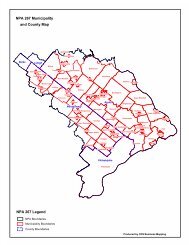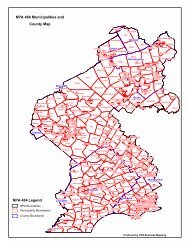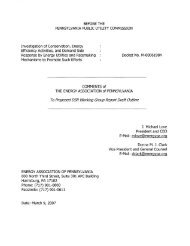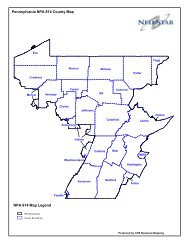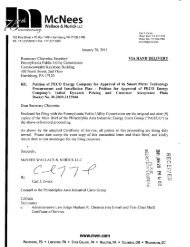METROPOLITAN EDISON COMPANY - Pennsylvania Public Utility ...
METROPOLITAN EDISON COMPANY - Pennsylvania Public Utility ...
METROPOLITAN EDISON COMPANY - Pennsylvania Public Utility ...
- No tags were found...
Create successful ePaper yourself
Turn your PDF publications into a flip-book with our unique Google optimized e-Paper software.
footprint in a particular RTO (i.e., PJM and the Midwest ISO). The simulations includeddetailed models of the Midwest ISO and PJM load generation and their respectiveconstraints. By including FirstEnergy’s load and generation into the PJM commitmentand dispatch process, FirstEnergy’s total system production costs were reduced by0.08% or about $26 million and total system congestion costs were reduced by 6.3% orabout $91 million, for the 12 month period included in the 2009 study. Approximately$16 million of this congestion cost was realized in the combined Met-Ed and Peneleczones as a result of the ATSI move. Therefore, at a minimum, the FE-PA Companiesrealized congestion cost savings of approximately $16 million during 2009 by movingthe ATSI from MISO to PJM. Additionally, savings will be realized annually into thefuture, but the impact of the savings is uncertain because the PJM simulations thatquantified the results from 2009 do not reflect 2010 and future economic conditions (i.e.,different economy, different transmission system, and different fuel prices).Furthermore, once the ATSI move to PJM is completed there will be no way toaccurately quantify future savings.Staff’s Follow-up Recommendation – None.Prior Recommendation – Include in the staffing study recommended in the ElectricReliability chapter a thorough review of the engineering resource needs of the FE-PACompanies.Prior Situation – In accordance with the Settlement Agreement, FirstEnergy conducteda line and substation workforce study for its three <strong>Pennsylvania</strong> operating companies.The study was a staffing analysis that examined each of the FE-PA Companies’ staffinglevels and how they were expected to be affected by retirement and non-retirementattrition. The study did not address the FE-PA Companies’ engineering capabilities andneeds as it was not required by the Settlement Agreement. Moreover, the consultantdid not find any other studies of FirstEnergy’s staffing levels that addressed the FE-PACompanies’ engineering resource needs.Follow-up Finding and Conclusion No. VII-2 – FirstEnergy conducted a review ofits engineering resource needs by developing an engineering staffing strategy toinclude a workload analysis, staffing forecast, sourcing strategy, etc.In 2007, FirstEnergy hired a consultant to perform a Workload and ManpowerPlanning Analysis to determine future staffing needs based on the work to beperformed. The consultant recommended a staffing database model approach butFirstEnergy did not implement the model as suggested because the model did not meetFirstEnergy’s accounting structure (i.e., the staffing database model could not fullyintegrate with the accounting program that FirstEnergy had in place). FirstEnergyupdated the model and refined the process to include additional focus on forecastingand planning workload and resource requirements. FirstEnergy developed sevenstaffing strategies in 2008 that included the following groups: engineering, line,substation, transmission and distribution, system operators, relay, and underground- 48 -



